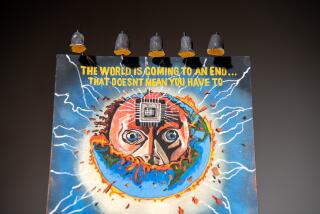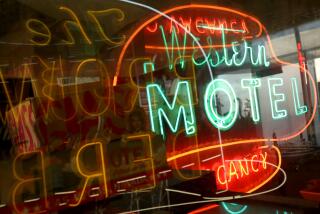Aesthetics in Advertising
- Share via
To many, an exhibition on vintage Polish movie posters might seem an exercise in curatorial esoterica. But “Western Amerykanski: Polish Poster Art and the Western” at the Autry Museum of Western Heritage in Griffith Park is compelling.
At a time when the “art” of movie marketing has virtually run amok, when every movie has its own Web site and aggressive marketing schemes, these handcrafted, artfully rendered designs seem to drift out of a dreamy otherworld. They suggest an era and a sensibility in movie marketing that America has never really known.
In this show, representing the “Polish Poster School” from the 1940s-’60s and some examples from the ‘70s, Western commerce meets Soviet-tinged Eastern European aesthetics. Unlike the crasser advertising agendas of the studio one-sheet posters in the United States, these amounted to a literal form of street art, created by specially commissioned artists for display on kiosks.
Specifically, the Western genre appealed to the Poles as metaphors for the struggle between the individual and potentially oppressive forces. Often, the lucid visual character of the American poster is transformed, in Polish terms, into something more abstract and stylized, as seen in Wojciech Wenzel’s stark image for “Shane” or the hollow cutout form of a cowboy in Jacek Neugebauer’s poster for “MacKenna’s Gold.”
Throughout the show, we get the sense that these artists and the eager audiences that made Westerns popular in Poland were at once respectful and skeptical of the lore of the movie cowboy. As archetypes go, it’s a ripe target for scorn and glorification.
Noted artist Jerzy Flisak’s poster for “Winchester ‘73” shows an expressionistic, cartoon-like style. His satire goes deeper in a poster for “El Dorado,” the cowboy turned into a Botero buffoon, all chubby limbs, a whiskey bottle for a hat and a crutch for a rifle. The fool in Sam Peckinpah’s “The Ballad of Cable Hogue” is seen in Flisak’s poster as a head full of water, with a spigot for a nose. From a different angle, the head outlined in barbed wire in Jakub Erol’s poster for “McMasters” symbolizes Native Americans’ oppression.
One subplot of this show is the way the world outside Hollywood redirects its products and fantasies to make them relevant to other cultures. It’s no fluke that Gary Cooper, the stoic messiah of the Wild West in “High Noon,” is viewed with reverence by Marian Stachurski and is later borrowed for a purely political message in Tomasz Sarnecki’s 1989 poster promoting Solidarity. In that, Cooper clutches a ballot instead of a six-shooter.
BE THERE
“Western Amerykanski: Polish Poster Art and the Western,” through Jan. 30 at the Autry Museum of Western Heritage, 4700 Western Heritage Way, Griffith Park. Gallery hours: 10 a.m.-5 p.m. Tuesday-Sunday. Admission is $7.50 for adults, $5 for seniors and students, and $3 for children. (323) 667-2000.
More to Read
The biggest entertainment stories
Get our big stories about Hollywood, film, television, music, arts, culture and more right in your inbox as soon as they publish.
You may occasionally receive promotional content from the Los Angeles Times.










